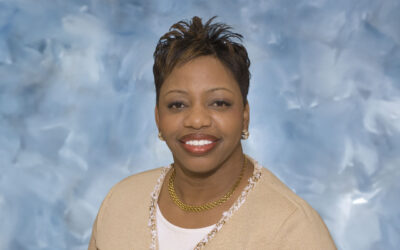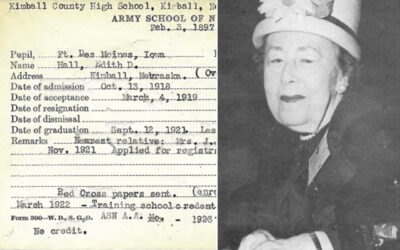By Matt Skoufalos
Ask most nurses what got them into the profession, and “the tree-climbing business” is not usually a response you’ll hear. But for a decade before John Steinmacher was at his patients’ bedsides, he was swinging from branches in homeowners’ backyards, several stories in the air, as a climber for hire.
“Mostly we deconstructed big trees in backyards,” he said. “It was a lot of labor, a lot of climbing. I realized at some point that I’d probably want to do something that had a living wage and that I could do up to retirement; something that my body could take.”
As much fun as it was, Steinmacher said that the tree business provided all the motivation he needed to “do something better.”
“You always need that hard labor job to realize that you need to go upward in life,” he said. “I started feeling like I was playing hooky on my life career.”
 Steinmacher started exploring the medical field. Ophthalmic technology seemed to have too low of an earnings ceiling for him; pharmacy school and the requisite Ph.D. program seemed too ambitious for his age. He considered becoming a physician’s assistant, until he learned that many of them begin their careers as nurses.
Steinmacher started exploring the medical field. Ophthalmic technology seemed to have too low of an earnings ceiling for him; pharmacy school and the requisite Ph.D. program seemed too ambitious for his age. He considered becoming a physician’s assistant, until he learned that many of them begin their careers as nurses.
“It looked more like something I could do and be happy with,” Steinmacher said. “I realized how many different places nursing can take you, how many different kinds of nursing there are, and the core value of helping people, helping others.”
Steinmacher, who already had a bachelor’s degree in German studies from the University of Pennsylvania, began his prerequisites at Camden County College in New Jersey, and eventually enrolled in an accelerated, one-year bachelor’s degree program at nearby Thomas Jefferson University in Philadelphia. He passed his NCLEX in accelerated fashion, too, wrapping up the examination in 75 questions. Shortly after graduation, he began his first job in the field, working as a three-quarter-time floor nurse at a continuing care retirement community in Moorestown, New Jersey.
“The first nursing job is hard to land unless you have connections, and I didn’t have any connections to health care,” Steinmacher said. “I was hired by Christopher Kenneally, the Director of Nursing. I worked there for two years before I got an offer for a better position at Collingswood Manor by the Director of Nursing there — who was Christopher Kenneally.”
 At Collingswood Manor, a 60-bed residential facility where Steinmacher currently serves as the Evening Coordinator of health care nurses, he enjoys a supervisory role in which he assesses residents, administers medications, and helps his charges in their daily activities. Best of all, the job is located in his hometown. His commute is only a few blocks by foot, and the noon-to-8 p.m. shift allows him to span the day and evening work, the better to coordinate workflow and a continuity of care at the facility.
At Collingswood Manor, a 60-bed residential facility where Steinmacher currently serves as the Evening Coordinator of health care nurses, he enjoys a supervisory role in which he assesses residents, administers medications, and helps his charges in their daily activities. Best of all, the job is located in his hometown. His commute is only a few blocks by foot, and the noon-to-8 p.m. shift allows him to span the day and evening work, the better to coordinate workflow and a continuity of care at the facility.
“The doctors will seek the advice of their eyes and ears, the nurses, and their other specialists,” Steinmacher said. “A nurse works an eight-hour shift three or four days in a row, and then they’re not there. The next nurse in gets a report, but it’s a five-minute report on 20 people. So there will be somebody in who the next nurse in can ask questions of and get information from.”
A major aspect of Steinmacher’s responsibilities includes maintaining positive morale among the staff under his charge while driving a resident-directed model of care, which he said represents a departure from the traditional approach. Resident-directed care helps to resolve some of “the classic problems that nursing homes have,” Steinmacher said — namely compliance with medication regimens, doctor’s orders, and dietary and exercise routines — while reducing negative behaviors that can affect the community.
“If you assess a person’s likes and dislikes, and then pay attention to those and honor those preferences, the resident is much easier to care for,” he said.
Migrating to “a much more home-like model,” with flexible dining and waking times, and working to incorporate the on-campus apartments into a “home on a street” atmosphere improves the quality of patients’ lives, which also makes the facility operate more smoothly, and helps retain clients, Steinmacher said.
“These people have choices, and the hospitals in the area need to compete — and so do the long-term care facilities — for residents,” he said. “People usually have two and three choices; they have preferences, and they can talk to other people who are already there. They can tour the facilities. If they went there for rehab, they can choose to come back or they can be somewhere else.”
“If the residents are doing better, then the nurses are doing better, and the management is doing better,” Steinmacher said. “As management and a person who hopes for the best in general, part of [my job] is to facilitate that positive outlook. When there’s negative vibes going around and there’s change, I keep it on the positive to keep the morale up.”
As the patient-directed care model evolves, it will change Steinmacher’s role in the facility as well: his responsibilities will lie more in providing mentorship to the staff underneath him while also reducing his direct resident caseload by as much as two-thirds. Steinmacher said that should allow him to reach patients one-on-one, the aspect of his job that he finds the most gratifying.
“It’s a needy population,” he said. “It’s gratifying to get the thanks you get several times a day from helping people. Feeling appreciated is a reward. It’s a very valuable benefit.”
It’s certainly not the only advantage to working in the field — as opposed to working in a tree — that he touts.
“You have job security,” Steinmacher said. “You get to be a part of a team that’s really doing something positive, whether you’re in hospital, hospice, or long-term care.”
“There’s almost no limit for upward mobility,” he said.










